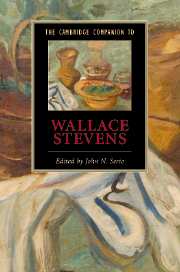Book contents
- Frontmatter
- Introduction
- 1 Wallace Stevens: A Likeness
- 2 Stevens and Harmonium
- 3 Stevens in the 1930s
- 4 Stevens and the supreme fiction
- 5 Stevens’ late poetry
- 6 Stevens and his contemporaries
- 7 Stevens and romanticism
- 8 Stevens and philosophy
- 9 Stevens’ seasonal cycles
- 10 Stevens and the lyric speaker
- 11 Stevens and linguistic structure
- 12 Stevens and painting
- 13 Stevens and the feminine
- 14 Stevens and belief
- Further reading
- Index
13 - Stevens and the feminine
Published online by Cambridge University Press: 28 May 2007
- Frontmatter
- Introduction
- 1 Wallace Stevens: A Likeness
- 2 Stevens and Harmonium
- 3 Stevens in the 1930s
- 4 Stevens and the supreme fiction
- 5 Stevens’ late poetry
- 6 Stevens and his contemporaries
- 7 Stevens and romanticism
- 8 Stevens and philosophy
- 9 Stevens’ seasonal cycles
- 10 Stevens and the lyric speaker
- 11 Stevens and linguistic structure
- 12 Stevens and painting
- 13 Stevens and the feminine
- 14 Stevens and belief
- Further reading
- Index
Summary
The subject of Wallace Stevens and the feminine proves to be extremely important in understanding a poet who, from the meditating woman of his early “Sunday Morning” to the composing Penelope of his late “The World as Meditation,” produced a variety of female characters even as he explored some of his most important philosophical, metaphysical, and even spiritual questions. It is not surprising that as a poet, living in what he called the “epic of disbelief” (101), Stevens would take recourse in a traditional poetic trope - that is, that like Petrarch or Dante before him, he would often employ a female muse when exploring his most pressing and nearly ineffable questions. As the world and, especially, quite conservative parts of the United States faced the tumultuous changes from the traditional and religious values of the nineteenth century to the more skeptical and agnostic ones of the twentieth, such a poetic gesture might have provided something of the familiar, an aesthetic comfort zone that allowed for poetic production, even while Stevens struggled to create a modern poetry that would suffice in these changing and troubling times.
Yet invoking a female muse, as he does in “To the One of Fictive Music,” was itself a problematic gesture during Stevens' times, for the world not only witnessed the Great War, the Great Depression, and World War II, but also markedly different and changing attitudes toward women. The turn of the century saw, for example, the rise of “the new woman,” both in the United States and in Europe. Mina Loy, an experimental poet who immigrated to the United States in the 1910s, advocated “free sex,” and Isadora Duncan, famously performing a new ballet in France at the same time, scandalously danced with notably bare (or “free”) feet. Taken together, these two women might be said to embody the sometimes desired, sometimes feared modern woman who frequently advocated radically new mores for the relationship between men and women.
- Type
- Chapter
- Information
- The Cambridge Companion to Wallace Stevens , pp. 180 - 192Publisher: Cambridge University PressPrint publication year: 2007

